Assessment of Ionospheric Gradient Impacts on Ground-Based Augmentation System (GBAS) Data in Guangdong Province, China
Abstract
:1. Introduction
2. Improved “Simple Truth” Algorithm
- The cycle slip detection and outlier removal are performed on the carrier-phase measurements in the range domain before the initial value of the ionospheric delay is calculated. The method of Melbourne-Wubbena [18] and the ionospheric total electron content rate [19] are simultaneously used to detect the cycle slips and outliers for removal. Because of the influence of noise in the code range observations, the ability of the Melbourne-Wubbena method to detect small cycle slips is limited, although the method can detect large cycle slips well. However, the ionospheric total electron content rate uses only the carrier-phase measurements, so the observational noise is small; therefore, this method can better detect the small cycle jumps. Thus, the combination of the Melbourne-Wubbena method and the ionospheric total electron content rate method can effectively detect cycle slips.
- The primary function of the subarc merger algorithm is to merge adjacent subarcs, separated into subarcs by outliers, into a continuous arc [10,20]. The traditional algorithm may mistakenly merge subarcs caused by cycle slips rather than by outliers into a continuous arc. The error caused by incorrectly treated cycle slips is then transferred into a leveling error in the incorrect continuous arc. To reduce this error, we propose a dual-fitting method performed on each continuous arc (data gaps are identified as gaps of more than 3600 s between continuous arcs). In this dual-fitting method, a polynomial fit is first performed on the adjacent subarcs and to obtain the polynomials and . Second, the residuals and are computed at the last point of the first subarc and the first point of the second subarc, as shown in Equations (9) and (10). Third, the difference between and is computed using Equation (11). If the largest value of is less than 0.5 m and the value of is less than 0.8 m, the two adjacent subarcs can be merged into one continuous arc [20].
3. Statistics and Modeling of Ionospheric Gradient
3.1. Data from the Guangdong GPS Stations
3.2. Ionospheric Gradient
3.2.1. Abnormal Condition 1: 25 March 2017
3.2.2. Abnormal Condition 2: 24 March 2017
3.2.3. Ionospheric Threat Model in Guangdong Province
4. Impacts of Ionospheric Gradients on GBAS
4.1. Simulation Conditions
4.2. Impacts of the Ionospheric Gradient Sigma on GBAS
4.3. Impacts of Ionospheric Anomaly Gradients on GBAS
5. Conclusions
Acknowledgments
Author Contributions
Conflicts of Interest
References
- Cho, J.; Yun, Y.; Heo, M.B. GBAS ionospheric anomaly monitoring strategy using Kullback-Leibler divergence metric. IEEE Trans. Aerosp. Electron. Syst. 2015, 51, 565–574. [Google Scholar] [CrossRef]
- Eurocae. Minimum Operational Performance Specification for Global Navigation Satellite Ground Based Augmentation System Ground Equipment to Support Category I operations. In Tech Report ed-114a; Eurocae: Malakoff, France, 2013. [Google Scholar]
- Xue, R.; Wang, Z.; Zhu, Y. Upper bound estimation of positioning error for ground-based augmentation system. GPS Solut. 2017, 21, 1–10. [Google Scholar] [CrossRef]
- Raghunath, S.; Ratnam, D.V. Ionospheric Gradient Detection Methods for Ground Based Augmentation System. In Proceedings of the 2015 2nd International Conference on Electronics and Communication Systems (ICECS), Coimbatore, India, 26–27 February 2015; pp. 894–898. [Google Scholar]
- Wang, Z.; Macabiau, C.; Zhang, J.; Escher, A.-C. Prediction and analysis of gbas integrity monitoring availability at Linzhi Aairport. GPS Solut. 2013, 18, 27–40. [Google Scholar] [CrossRef]
- Guenter, D.; Dennis, J. Initial operational experience with CAT I ground based augmentation system (GBAS). In Proceedings of the 2015 Integrated Communication, Navigation and Surveillance Conference (ICNS), Herdon, VA, USA, 21–23 April 2015; pp. S1-1–S1-14. [Google Scholar]
- Ammana, S.R.; Achanta, S.D. Estimation of overbound on ionospheric spatial decorrelation over low-latitude region for ground-based augmentation systems. IET Radar Sonar Navig. 2016, 10, 637–645. [Google Scholar] [CrossRef]
- Zhi, W.; Wang, Z.; Zhu, Y.; Li, R. Availability prediction method for EGNOS. Gps Solut. 2016, 21, 1–13. [Google Scholar] [CrossRef]
- Datta-Barua, S.; Lee, J.; Pullen, S.; Luo, M.; Ene, A.; Qiu, D.; Zhang, G.; Enge, P. Ionospheric threat parameterization for local area global-positioning-system-based aircraft landing systems. J. Aircr. 2010, 47, 1141–1151. [Google Scholar] [CrossRef]
- Kim, M.; Choi, Y.; Jun, H.-S.; Lee, J. GBAS ionospheric threat model assessment for category i operation in the Korean region. GPS Solut. 2014, 19, 443–456. [Google Scholar] [CrossRef]
- Lee, J.Y.; Yoon, M.S.; Sam, P.; Gillespie, J.; Mather, N.; Cole, R.; Souza, J.R.; Doherty, P.; Pradipta, R. Preliminary results from ionospheric threat model development to support GBAS operations in the Brazilian region. In Proceedings of the 28th International Technical Meeting of The Satellite Division of the Institute of Navigation (ION GNSS+ 2015), Tampa, FL, USA, 14–18 September 2015; pp. 1500–1506. [Google Scholar]
- RTCA. GNSS-based precision approach local area augmentation system (LASS) signal-in-space interface control document(ICD). In Tech Rep do-246d; RTCA: Washington, DC, USA, 2008. [Google Scholar]
- Lee, J.; Pullen, S.; Datta-Barua, S.; Enge, P. Assessment of ionosphere spatial decorrelation for global positioning system-based aircraft landing systems. J. Aircr. 2007, 44, 1662–1669. [Google Scholar] [CrossRef]
- Zhipeng, W.; Shujing, W.; Yanbo, Z.; Taosheng, W. GBAS ionosphere monitoring and assessment based on GPS data in beijing area. In Proceedings of the 2017 International Technical Meeting of The Institute of Navigation, Monterey, CA, USA, 30 January–1 February 2017; pp. 998–1007. [Google Scholar]
- Jin, R.; Jin, S.; Feng, G. M_dcb: Matlab code for estimating GNSS satellite and receiver differential code biases. GPS Solut. 2012, 16, 541–548. [Google Scholar] [CrossRef]
- Lee, J.; Jung, S.; Pullen, S. Enhancements of long term ionospheric anomaly monitoring for the ground-based augmentation system. In Proceedings of the International Technical Meeting of the Institute of Navigation, San Diego, CA, USA, 24–26 January 2011; pp. 930–941. [Google Scholar]
- Ma, G.; Maruyama, T. Derivation of tec and estimation of instrumental biases from Geonet in Japan. Ann. Geophys. 2003, 21, 2083–2093. [Google Scholar] [CrossRef]
- Dach, R.; Hugentobler, U.; Fridez, P.; Meindl, M. Bernese Gps Software Version 5.0. Available online: http://www.bernese.unibe.ch/docs50/DOCU50.pdf (accessed on 30 September 2017).
- Liu, M.; Chai, H.; Li, D. Cycle-Slip Detection and Correction Based on Polynomial-Fitting Ionosphere-Free Combination and Ionospheric Total Electron Contents Rate; Springer: Berlin/Heidelberg, Germany, 2015. [Google Scholar]
- Kim, M.; Seo, J.; Lee, J. A comprehensive method for gnss data quality determination to improve ionospheric data analysis. Sensors (Basel) 2014, 14, 14971–14993. [Google Scholar] [CrossRef] [PubMed]
- Rungraengwajiake, S.; Supnithi, P.; Saito, S.; Siansawasdi, N.; Saekow, A. Ionospheric delay gradient monitoring for GBAS by GPS stations near Suvarnabhumi Airport, Thailand. Radio Sci. 2015, 50, 1076–1085. [Google Scholar] [CrossRef]
- Kolb, P.F.; Chen, X.; Vollath, U. A new method to model the ionosphere across local area networks. In Proceedings of the ION GNSS 2005, Long Beach, CA, USA, 13–16 September 2005; pp. 705–711. [Google Scholar]
- RTCA. Minimum Operational Performance Standards for GPS Local Area Augmentation System Airborne Equipment; RTCA: Washington, DC, USA, 2008. [Google Scholar]
- Lee, J.; Jung, S.; Kim, M.; Seo, J.; Pullen, S.; Close, S. Results from automated ionospheric data analysis for ground-based augmentation systems (GBAS). Proc. Int. Tech. Meet. Inst. Navig. 2012, 3, 1451–1461. [Google Scholar]
- FAA, US. Specification: Performance Type One Local Area Augmentation System Ground Facility; FAA, US: Washington, DC, USA, 2002.
- RTCA. Minimum Aviation System Performance Standards for the Local Area Augmentation System (LASS), DO-245a; RTCA: Washington, DC, USA, 2004. [Google Scholar]
- Dautermann, T.; Felux, M.; Grosch, A. Approach service type d evaluation of the dlr GBAS testbed. GPS Solut. 2011, 16, 375–387. [Google Scholar] [CrossRef]
- EASA, CS. AWO-Certification Specifications for All Weather Operations. European Aviation Safety Agency, 2003. Available online: http://www.easa.europa.eu/system/files/dfu/decision_ED_2003_06_RM.pdf (accessed on 30 September 2017).
- Lacey, L. Criteria for Approval of Category III Weather Minima for Takeoff Landing and Rollout. AC 120-28D 1999. Available online: http://www.airweb.faa.gov/regulatory_and_Guidance_Library/rgAdvisoryCircular.nsf/0/bbada17da0d0bbd1862569ba006f64d0/$FILE/AC120-28D.pdf (accessed on 30 September 2017).
- Felux, M.; Lee, J.; Holzapfel, F. GBAS ground monitoring requirements from an airworthiness perspective. GPS Solut. 2014, 19, 393–401. [Google Scholar] [CrossRef] [Green Version]
- Burns, J.; Clark, B.; Cassell, R.; Shively, C.; Murphy, T.; Harris, M. Conceptual Framework for the Proposal for GBAS to Support CAT III Operations. ICAO NSP WGW Novemb. p. 133. Available online: https://www.icao.int/safety/airnavigation/documents/gnss_cat_ii_iii.pdf (accessed on 30 September 2017).
- Hatch, R. The Synergism of GPS Code and Carrier Measurements. In Proceedings of the International Geodetic Symposium on Satellite Doppler Positioning, New Mexico State University, Las Cruces, NM, USA, 8–12 February 1983; pp. 1213–1231. [Google Scholar]
- Jiang, Y.; Milner, C.; Macabiau, C. Code carrier divergence monitoring for dual-frequency GBAS. GPS Solut. 2016, 21, 769–781. [Google Scholar] [CrossRef]
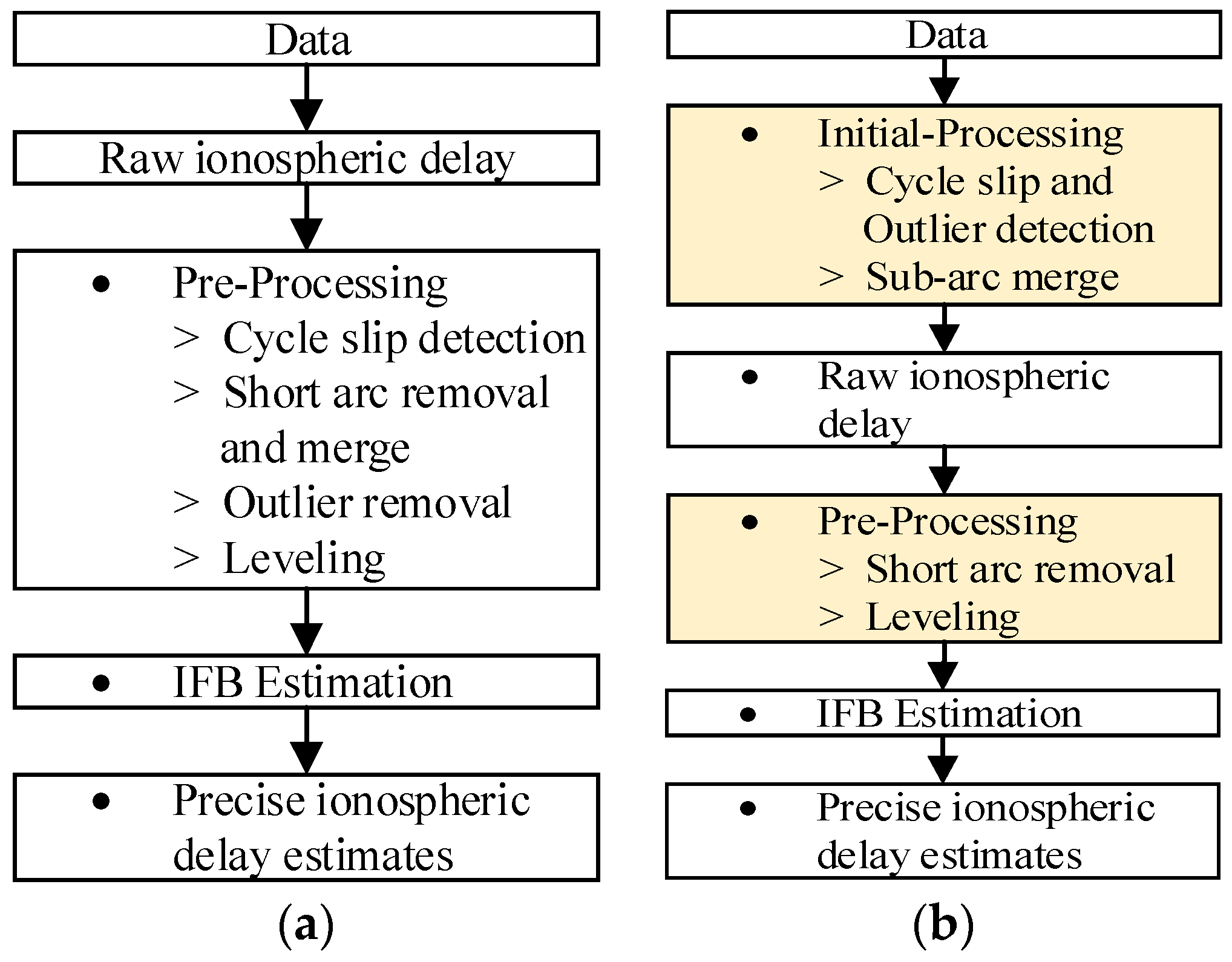
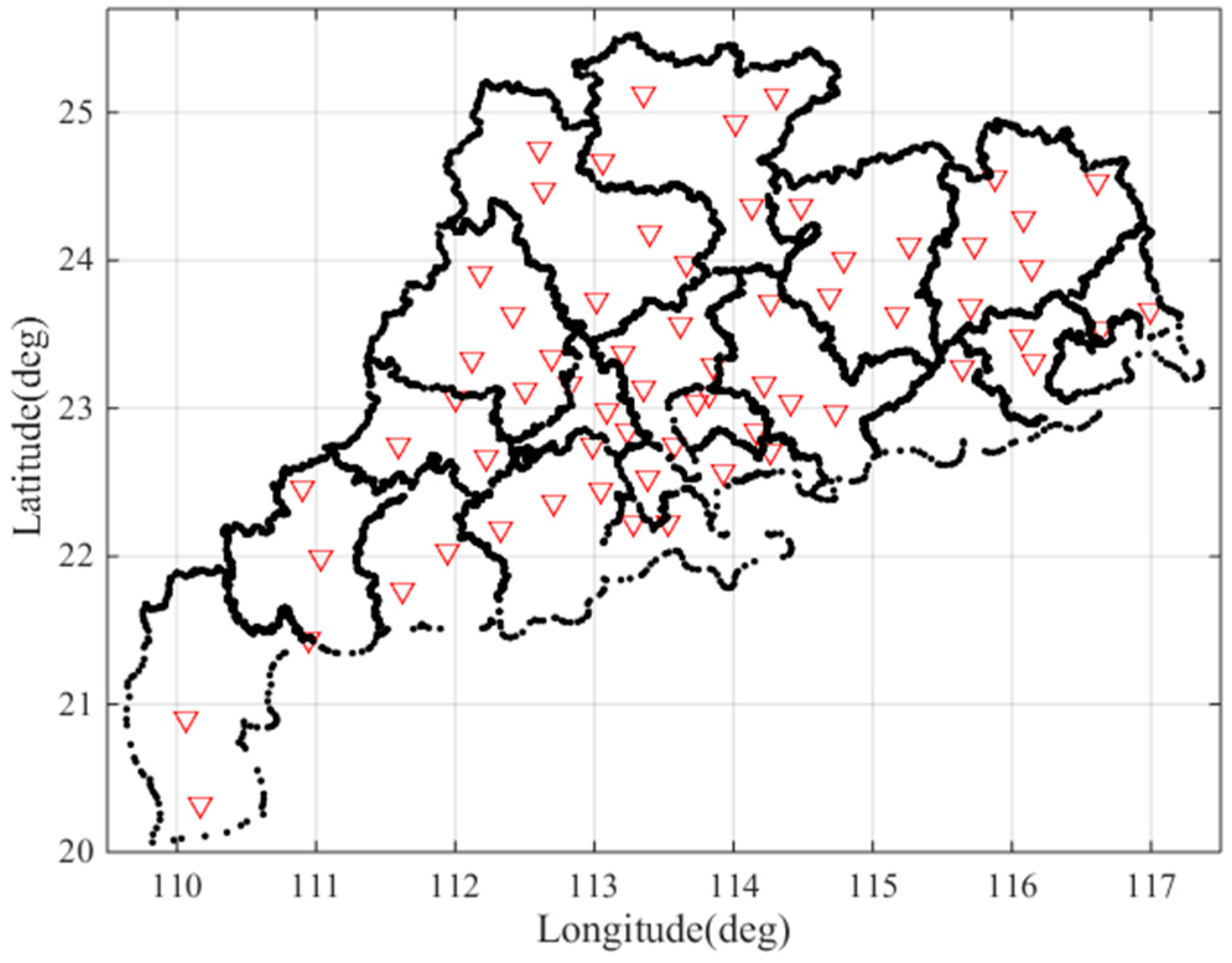
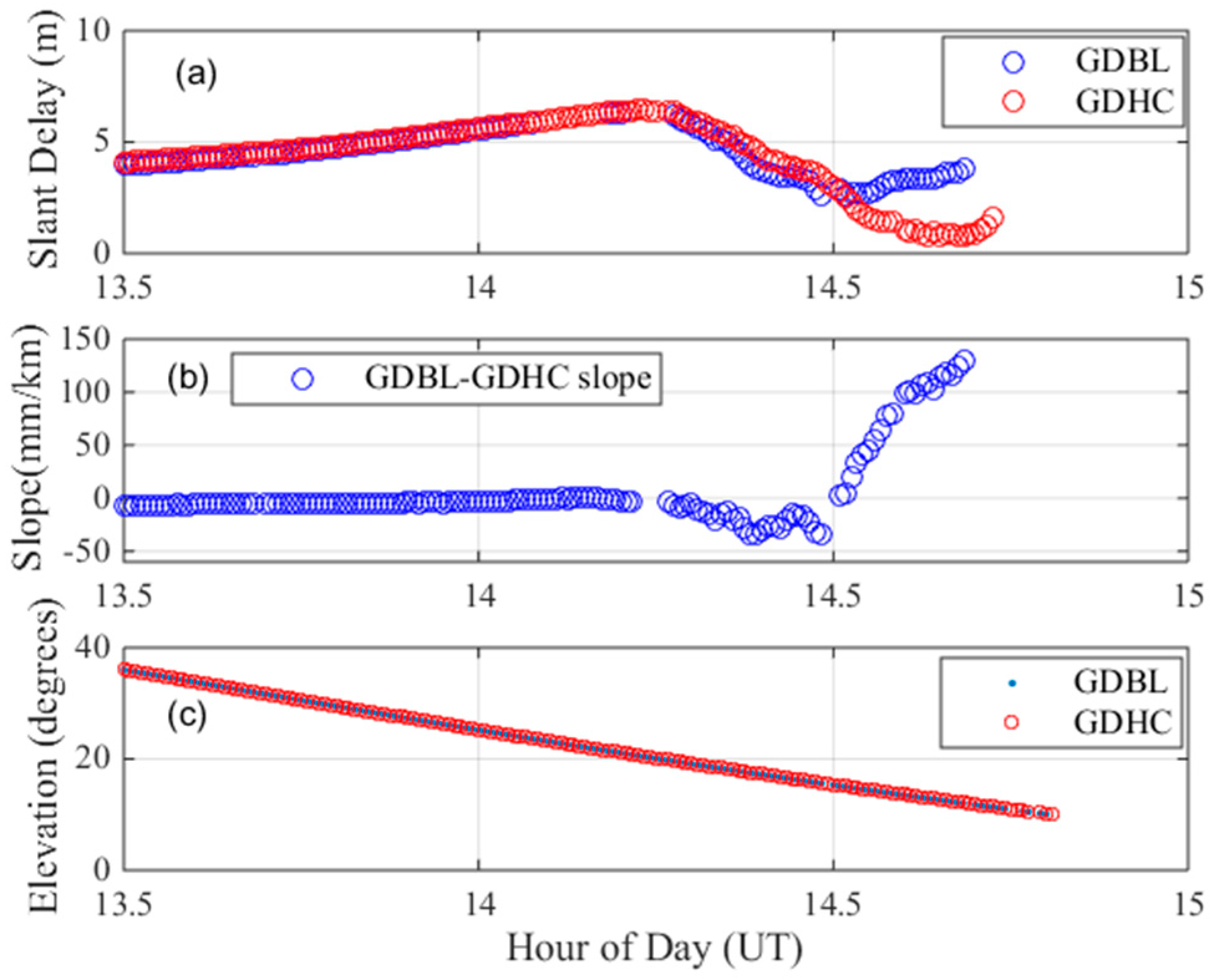
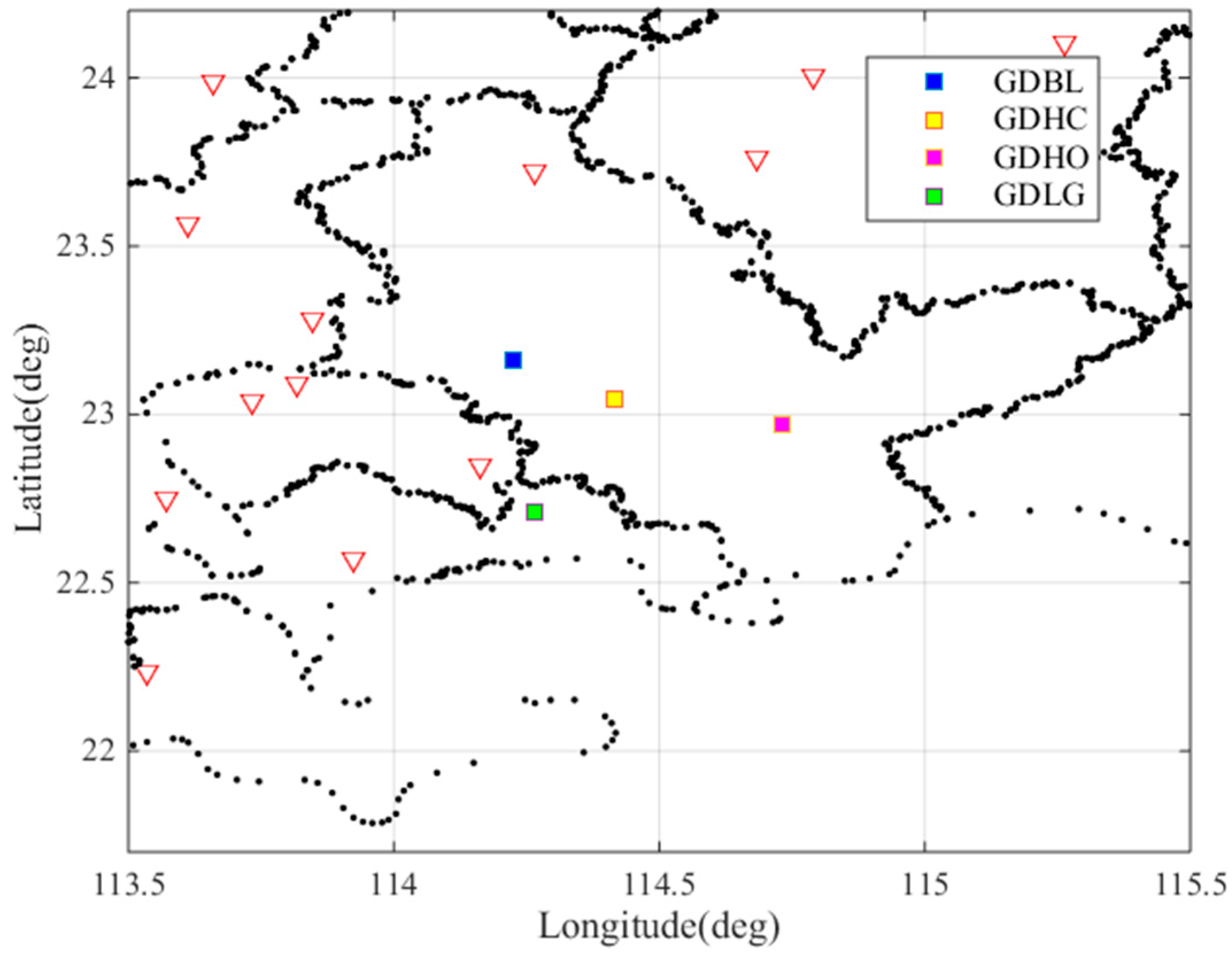
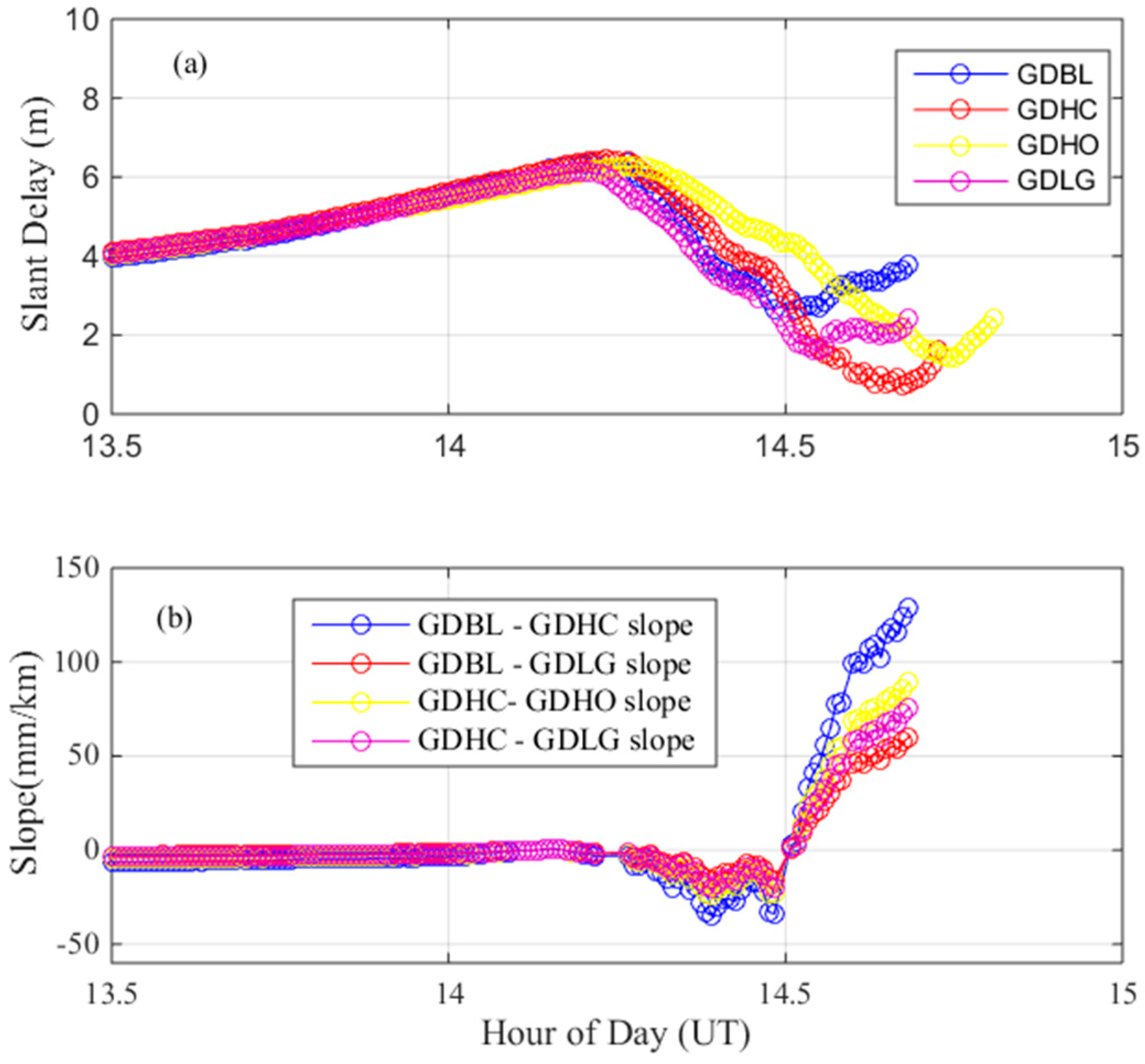

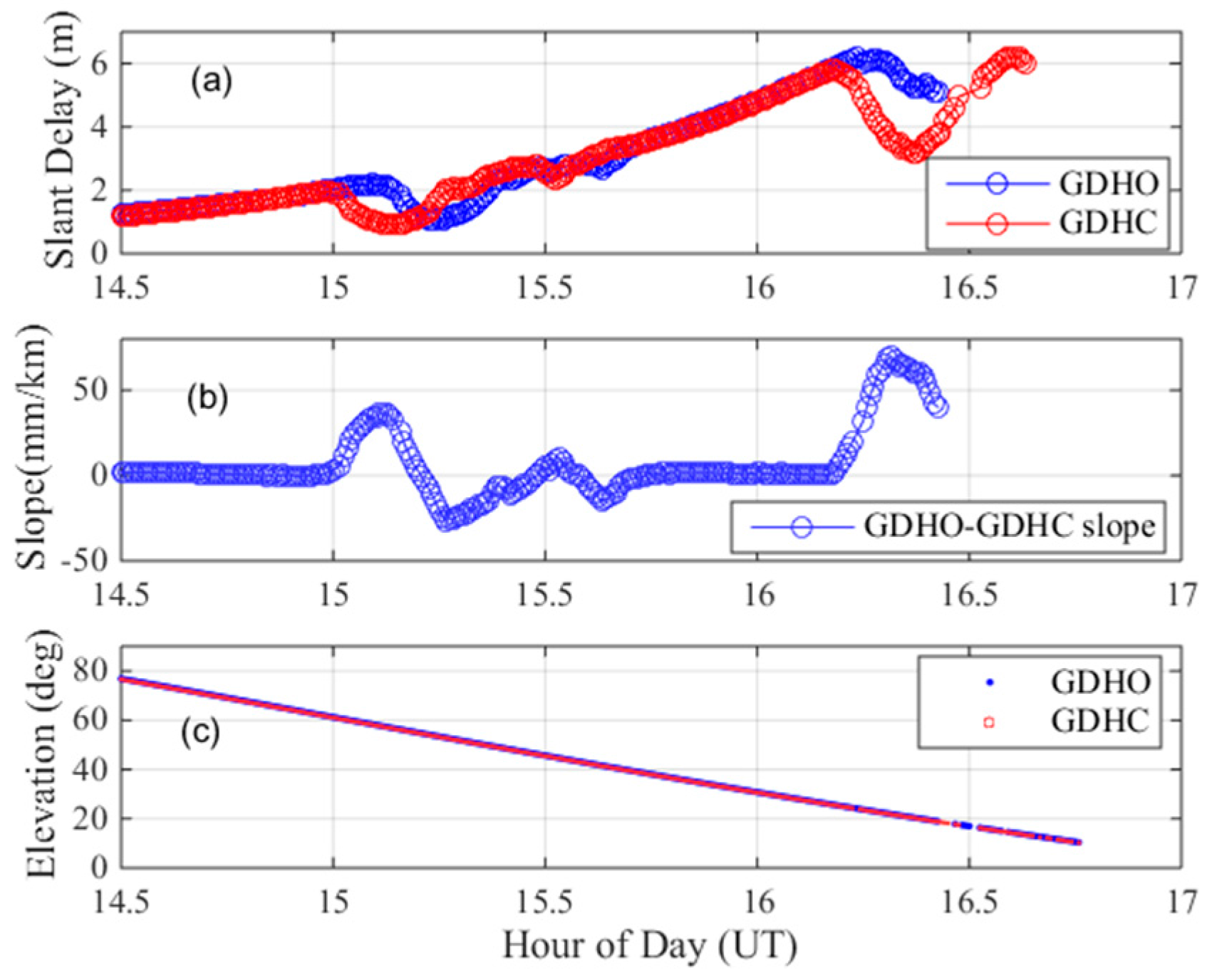


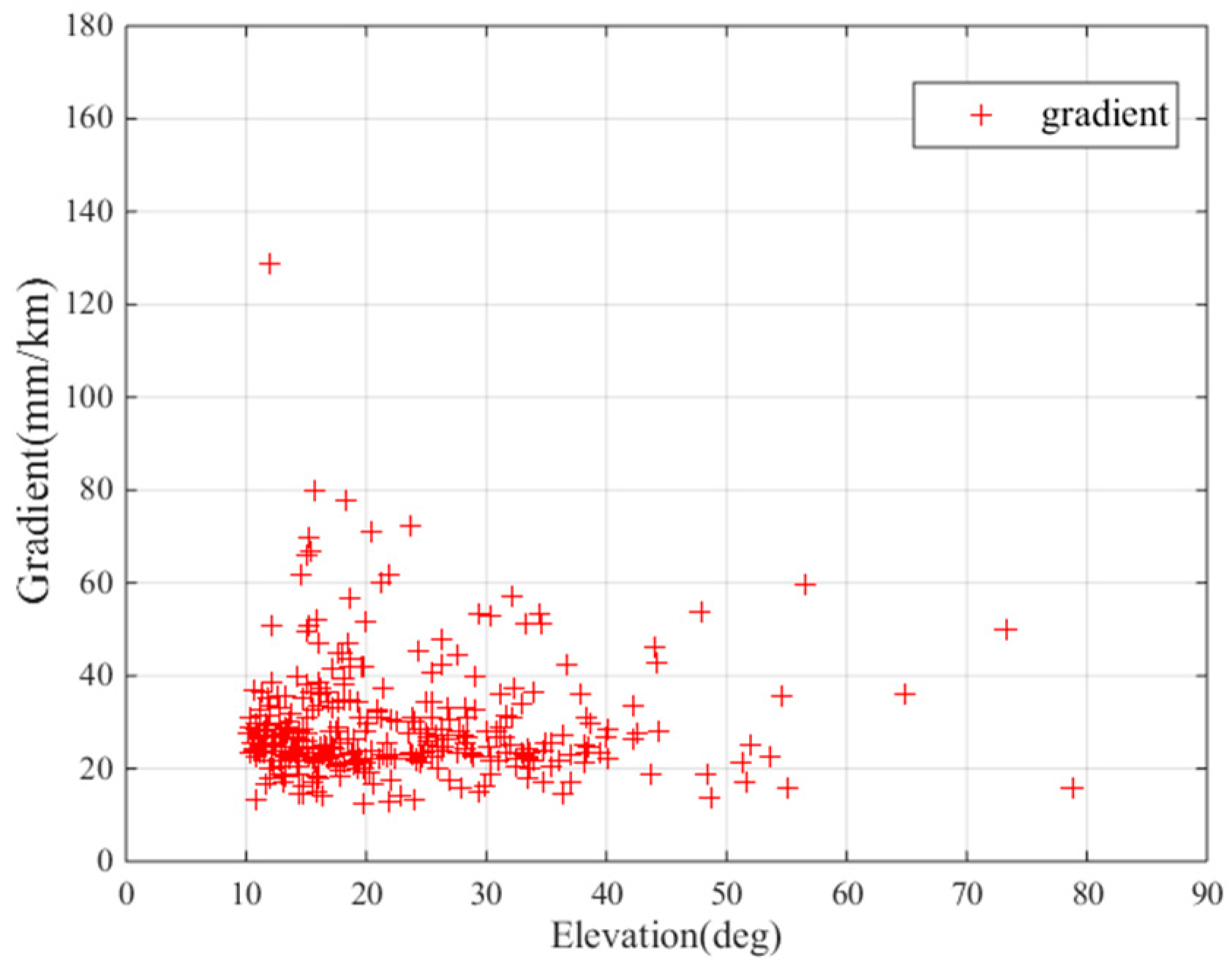

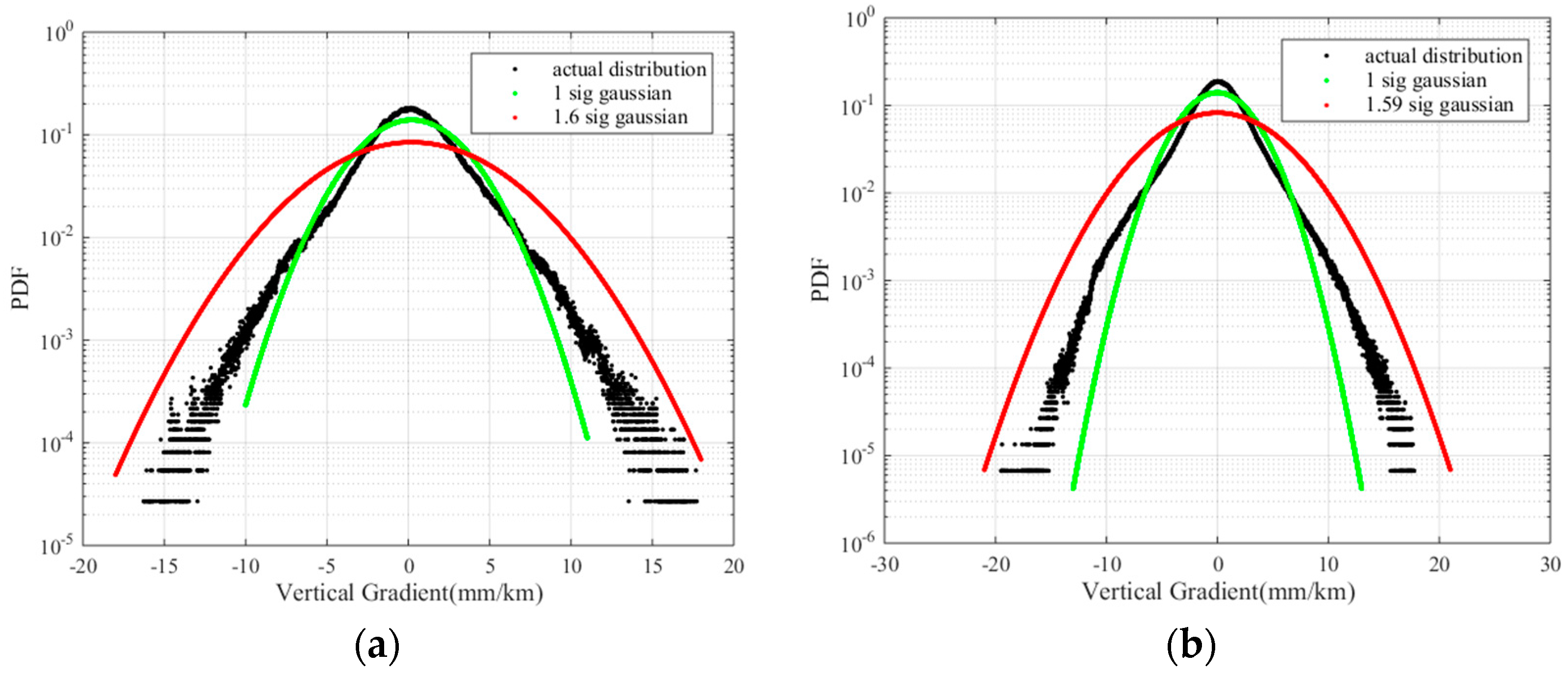
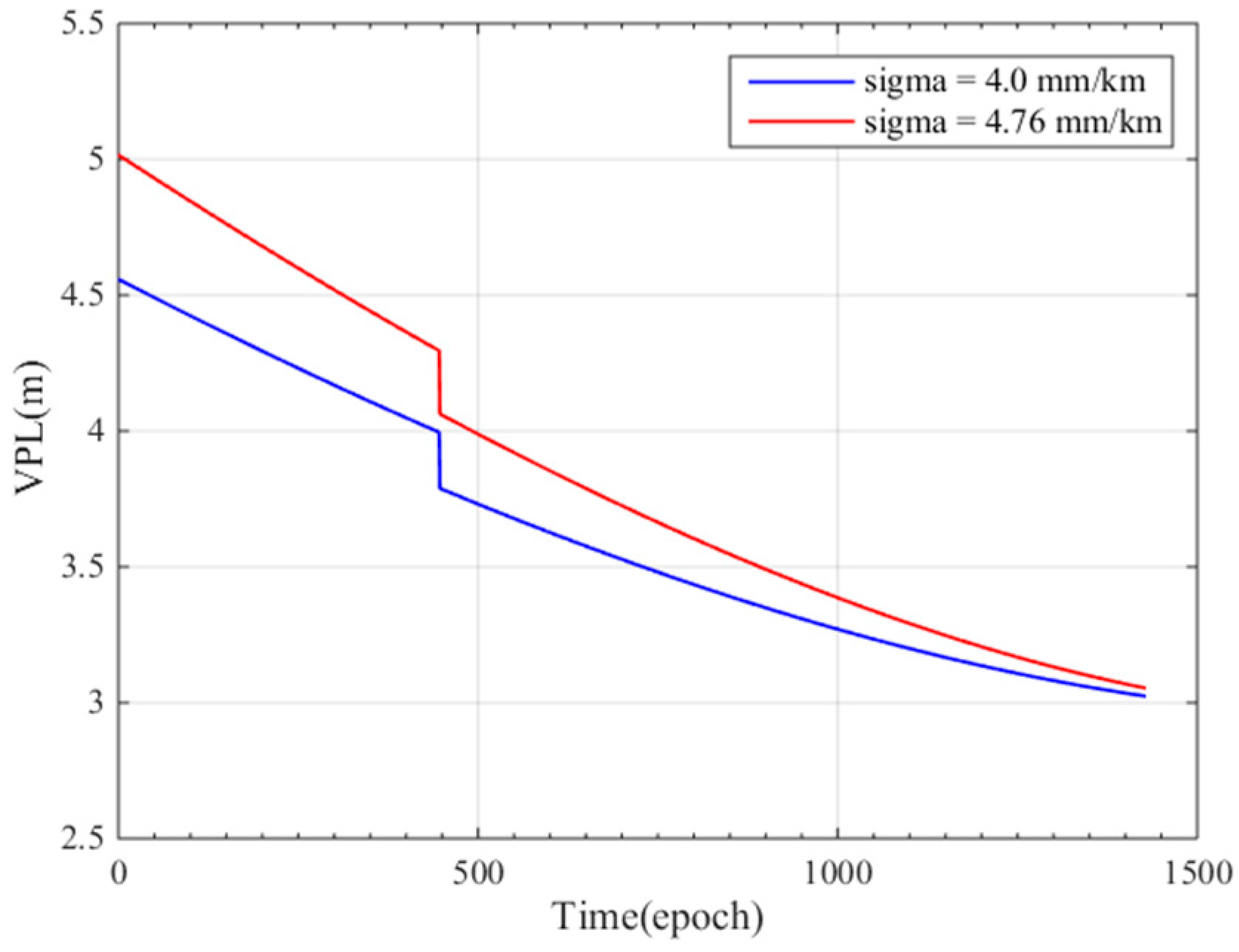


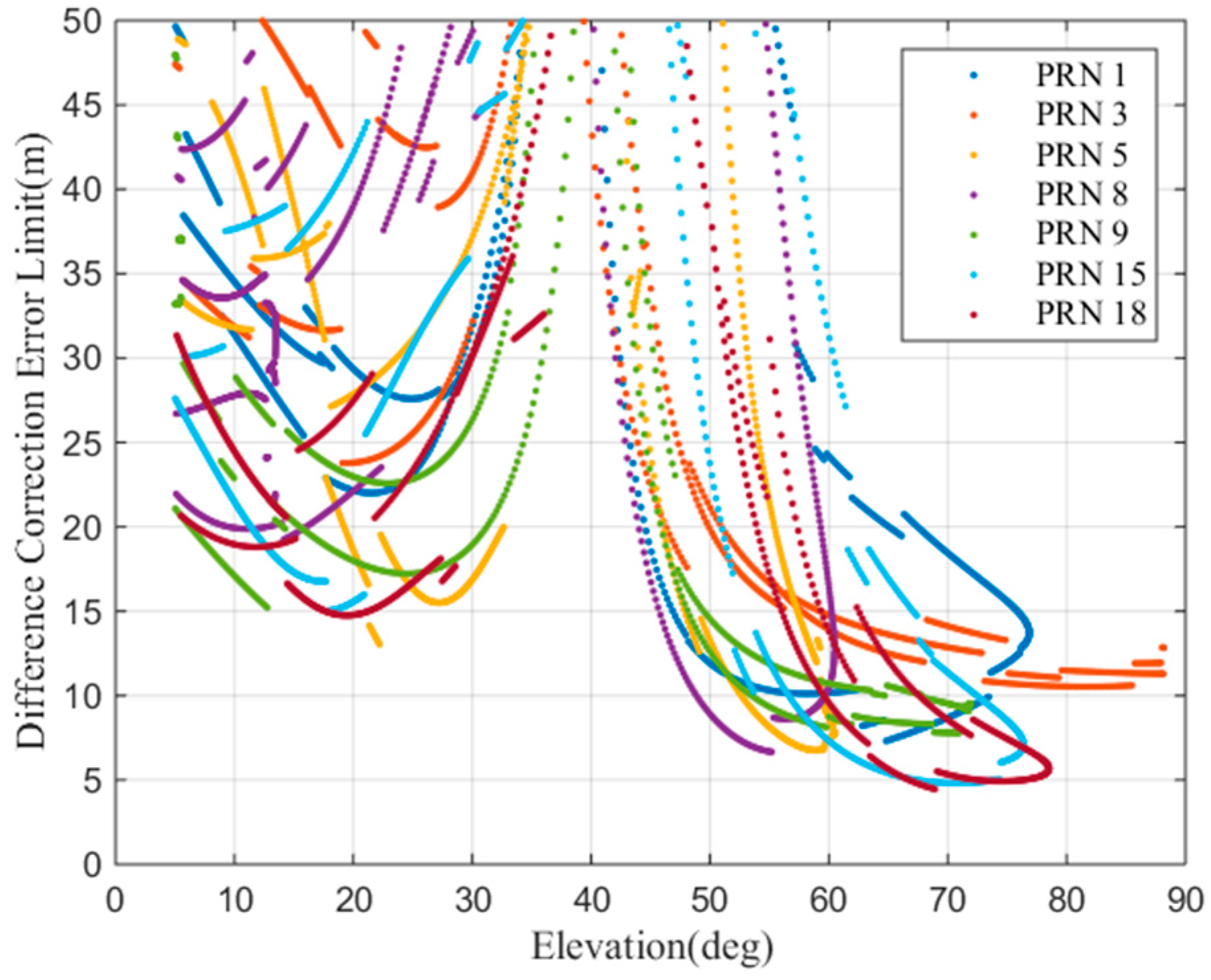
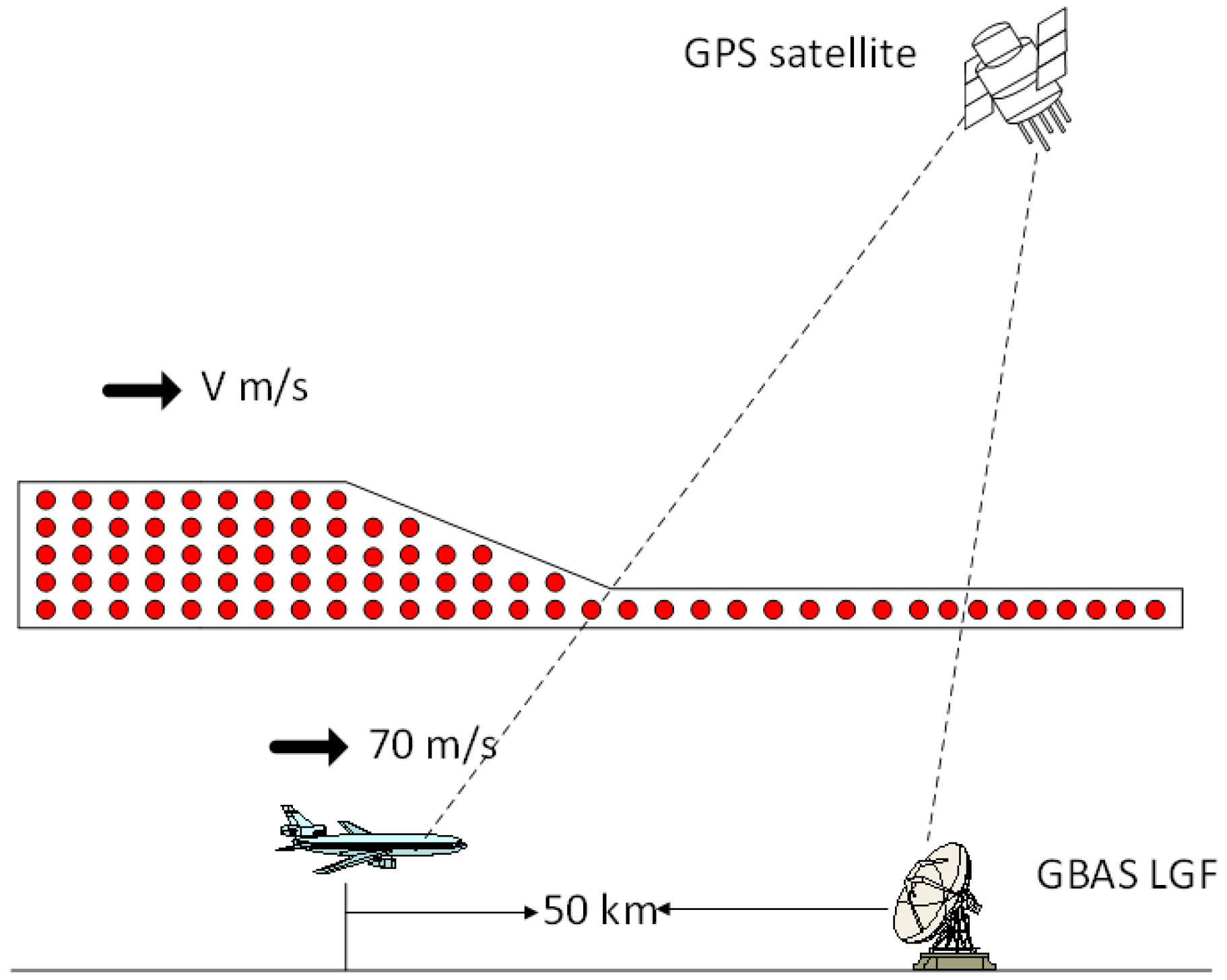
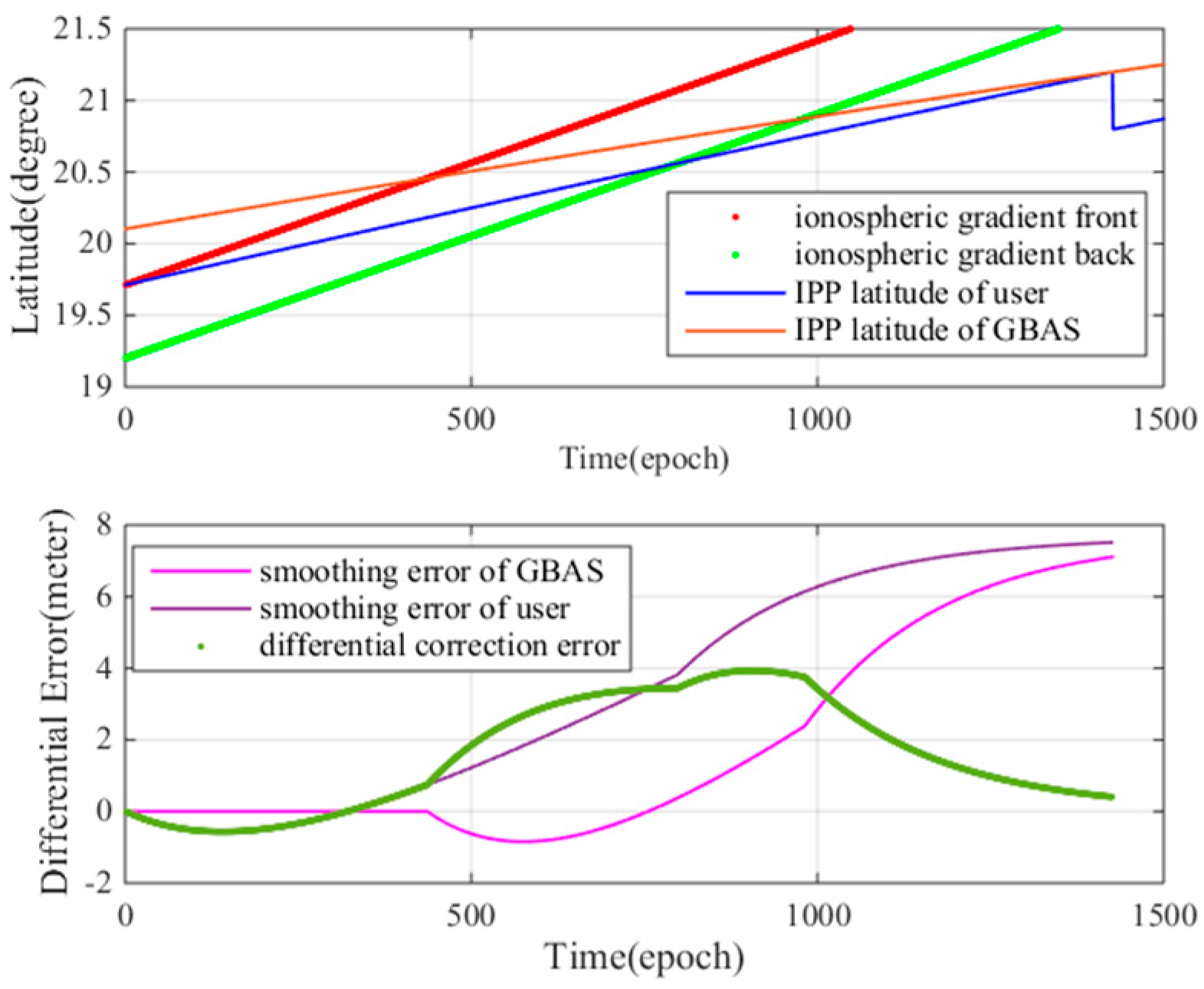


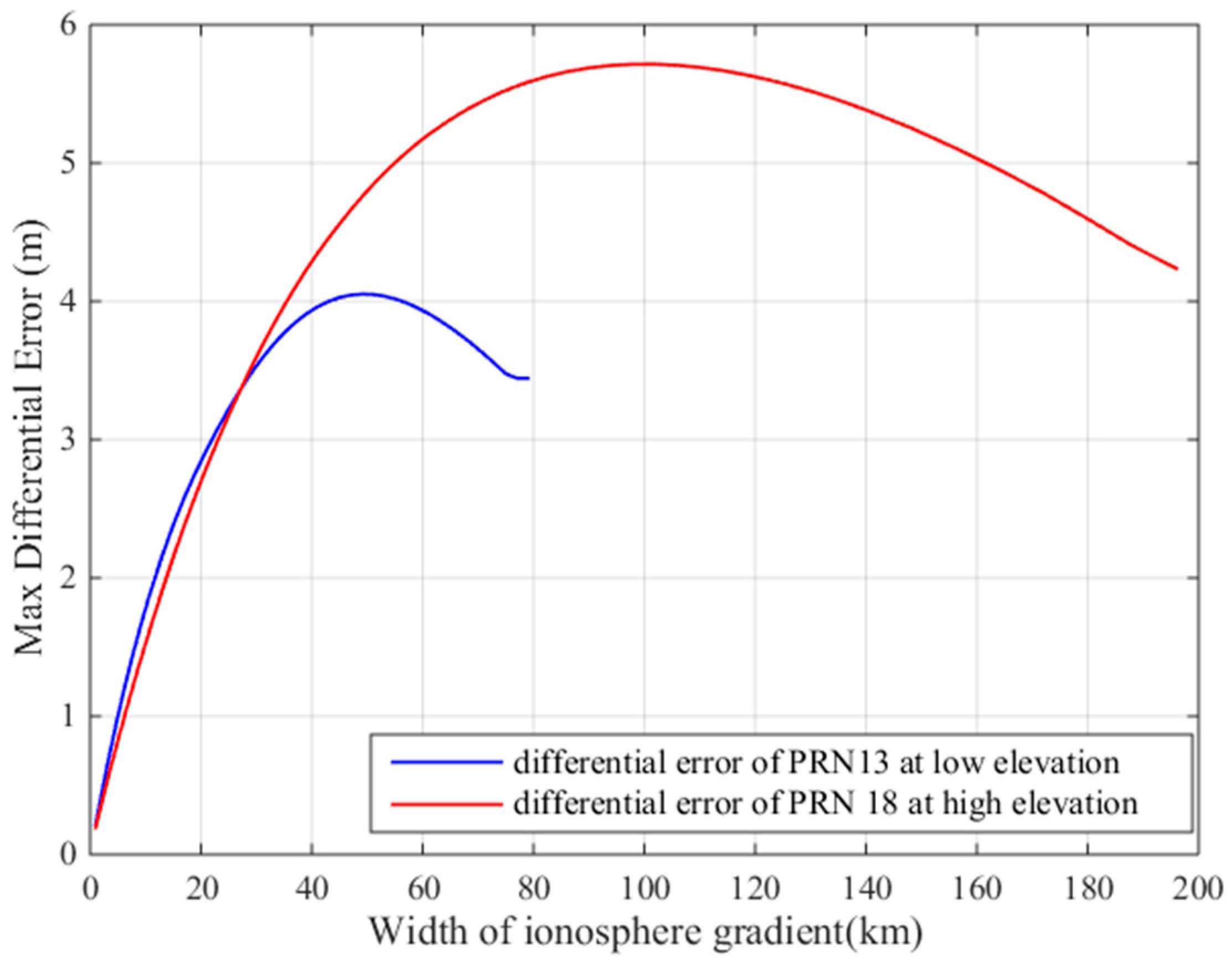
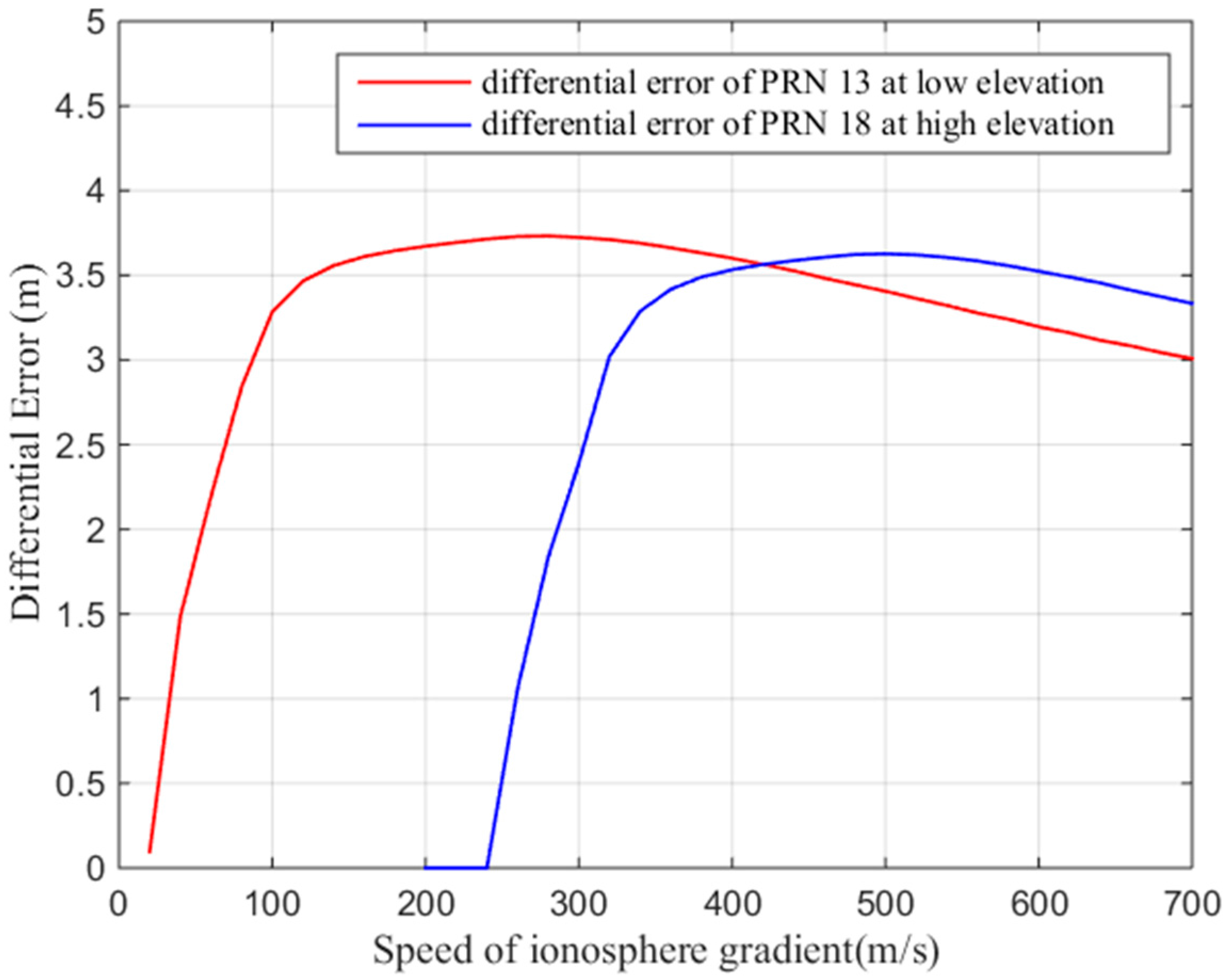
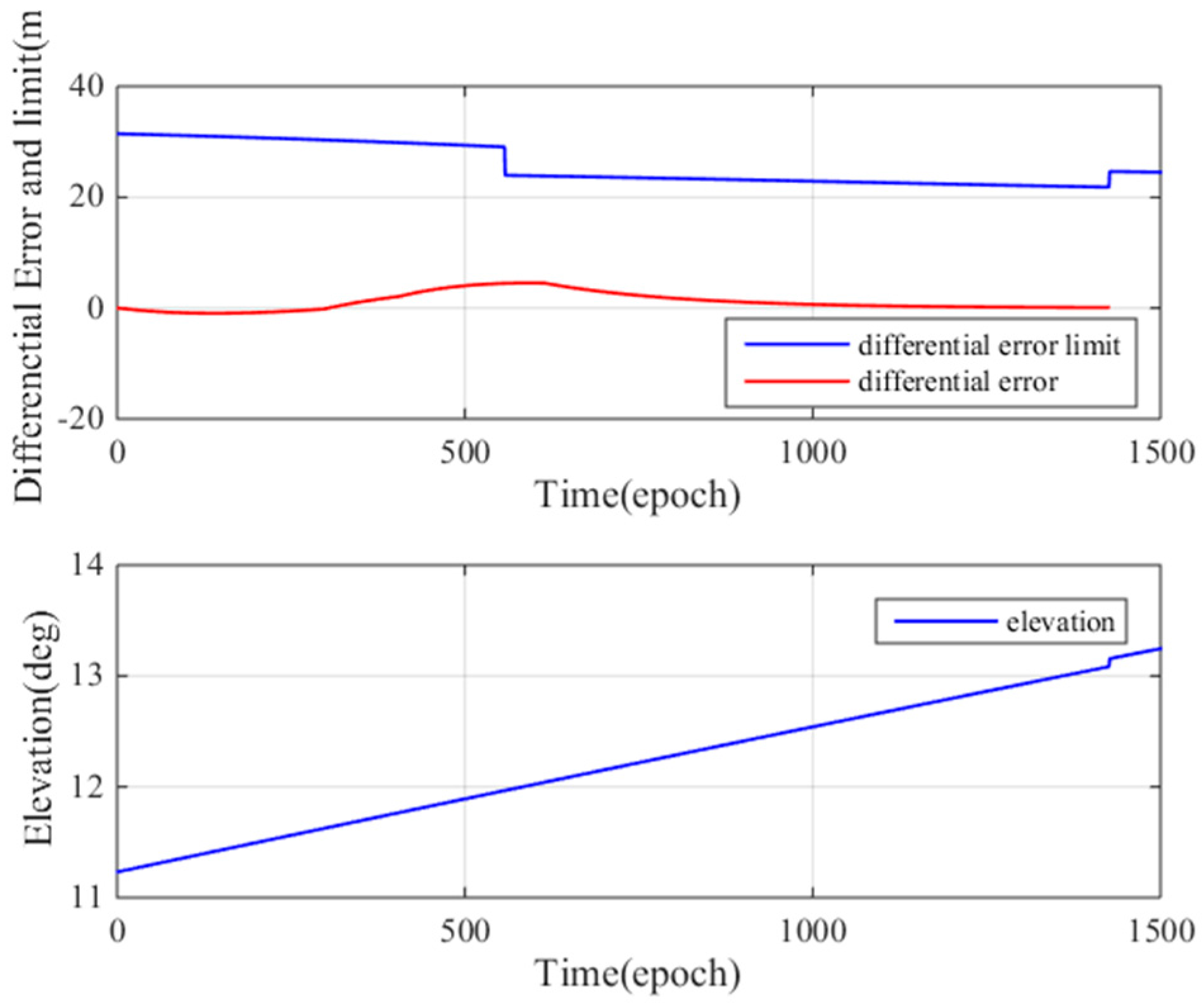

| PRN | Time | Gradient |
|---|---|---|
| 30 | 14.75 h | 128 mm/km |
| 28 | 15.5 h | 45 mm/km |
| 5 | 15.9 h | 12.5 mm/km |
| Parameter | Description |
|---|---|
| Ground Accuracy Designator | GAD-C |
| Aircraft Accuracy Designator | AAD-B |
| 7.6 km | |
| 4 | |
| GPA | 3° |
| 70 m/s | |
| 4.76 mm/km | |
| 6378.1363 km | |
| 350 km | |
| 100 s | |
| Max ionospheric gradient | 128 mm/km |
| Parameter | Description |
|---|---|
| Ionospheric velocity | 400 m/s |
| Ionospheric direction | South to north |
| Ionospheric tip width | 60 km |
| Ionospheric gradient | 128 mm/km |
© 2017 by the authors. Licensee MDPI, Basel, Switzerland. This article is an open access article distributed under the terms and conditions of the Creative Commons Attribution (CC BY) license (http://creativecommons.org/licenses/by/4.0/).
Share and Cite
Wang, Z.; Wang, S.; Zhu, Y.; Xin, P. Assessment of Ionospheric Gradient Impacts on Ground-Based Augmentation System (GBAS) Data in Guangdong Province, China. Sensors 2017, 17, 2313. https://doi.org/10.3390/s17102313
Wang Z, Wang S, Zhu Y, Xin P. Assessment of Ionospheric Gradient Impacts on Ground-Based Augmentation System (GBAS) Data in Guangdong Province, China. Sensors. 2017; 17(10):2313. https://doi.org/10.3390/s17102313
Chicago/Turabian StyleWang, Zhipeng, Shujing Wang, Yanbo Zhu, and Pumin Xin. 2017. "Assessment of Ionospheric Gradient Impacts on Ground-Based Augmentation System (GBAS) Data in Guangdong Province, China" Sensors 17, no. 10: 2313. https://doi.org/10.3390/s17102313




